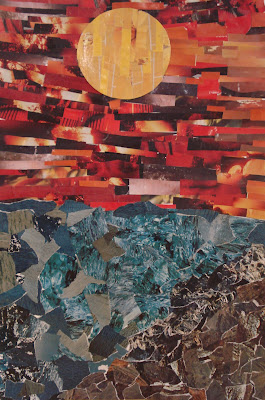My Grade 9's recently finished their landscape collages. I wanted a landscape lesson that wasn't drawing-based and I also wanted to use up a bunch of old magazines and scraps of coloured construction paper, so this project was the perfect solution. It uses minimal materials to get quite lovely results.
Students were required to create a landscape that incorporated a background, middle ground and foreground. For the paper, they had to use a combination of ripped and cut (with scissors) paper to create contrasting shapes and a variety of textures.
For inspiration, you could show students the work of California collage artist Eileen Downes.
They started by sketching out a plan for their landscape- a simple pencil drawing- and labeling what colours would go where. (see below) They could re-create any type of landscape they wished (seascape, cityscape, landscape, etc). We used heavy-ish white paper, about 12 x 18 inches.
Then they looked through the magazines and ripped/cut/collected the necessary colours.
They started gluing, with watered down white glue and a paintbrush, from the sky (background) and worked their way down to the bottom.
I gave them manila envelopes to store all their pieces between classes.
This project was quite time-consuming and took about 5-7 classes to complete. If you want to spend less time on these, use smaller paper- like 9 x 12". For my really slow-paced students, I accomodated them by giving them smaller paper to work with; it helped alot.
Once dry, students can protect them with a coat of water-based varnish (ie: modge podge, etc).
Ta da!
 |
| This is based on Claude Monet's painting "The Cliff' at Etretat" |
 |
| The yellow brick road leading to Oz! |


















































